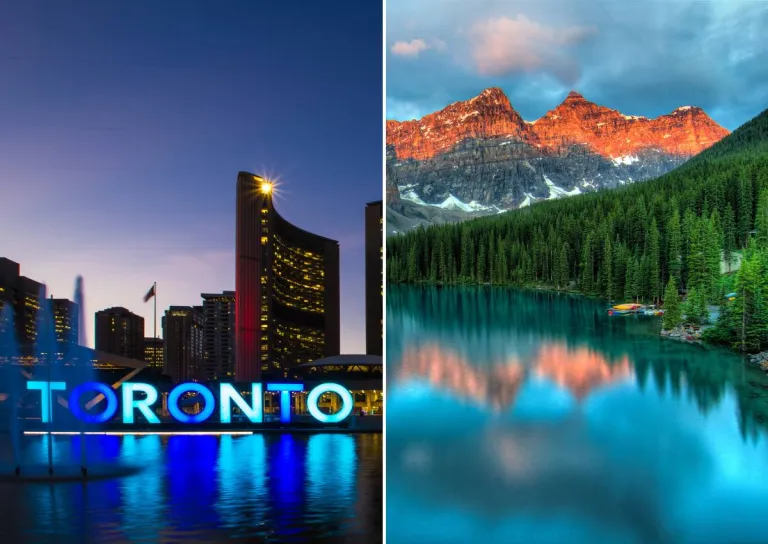Our favourite places to stay on this sleepy Cebu island.
Canada Tightens Rules on International Students and Temporary Workers

Canada has announced new restrictions on temporary workers and international students in an effort to reduce the number of temporary residents in the country. As public pressure mounts over issues like affordable housing and rising costs of living, the federal government is scaling back on study permits and work eligibility for certain groups.
Also read: 12 Best Cities to Live in Canada If You Want a Fresh Start
What we know about the Canada’s tighter rules for international students and temporary workers
 Image credit: (L-R) AmArtPhotography, adam668 via Canva Pro
Image credit: (L-R) AmArtPhotography, adam668 via Canva Pro
By 2025, Canada plans to limit the number of study permits issued to international students to 437,000, a significant drop from the 509,390 permits approved in 2023. The government is gradually decreasing the approvals, with 175,920 study permits already issued in the first seven months of 2024. The decision to limit the number of international students is part of a larger effort to control the temporary resident population, which stood at 6.8% of the total population as of April.
This move comes after the Canadian government introduced a two-year cap on international student approvals in January 2024, signalling a shift from its previous stance of welcoming growing numbers of students.
In addition to reducing study permits, the government will also tighten the rules on work permits for spouses of certain international students and temporary foreign workers. Previously, many spouses of temporary residents were eligible for work permits, allowing them to seek employment during their stay in Canada. Under the new guidelines, however, work permit eligibility will be restricted, particularly for those in low-wage jobs and sectors with high unemployment rates.
To combat visa fraud and reduce non-genuine visitors, the Canadian government is also reviewing visa decision-making processes. Immigration Minister Marc Miller emphasized that not everyone who wishes to come to Canada will be able to do so, and those who cannot demonstrate genuine intentions may face stricter scrutiny. This shift aims to maintain visa integrity while managing the influx of temporary residents.
Political and economic context
Prime Minister Justin Trudeau’s government is responding to growing public concern over immigration and its impact on housing and living costs, especially as Canada approaches a federal election by October 2025. While some blame temporary residents for economic challenges, immigration advocates argue that the connection between migrants and issues like inflation and housing shortages is oversimplified.
Despite these debates, the government has already taken steps to scale back its temporary foreign worker program, reducing the proportion of low-wage foreign workers allowed in certain sectors and communities with high unemployment rates.
Also read: Want to Migrate to Canada? Here Are the 12 Best Cities to Live in
These changes mark a significant shift in Canada’s immigration policy as it seeks to balance the economic contributions of temporary residents with growing social and political concerns.
Featured image credit: Andre Furtado via Canva Pro
Published at
About Author
Anne Mercado
Subscribe our Newsletter
Get our weekly tips and travel news!
Recommended Articles
10 Bantayan Island Resorts, Hotels, and Rentals for Your Tropical Escape 10 Best Mountain Cafes in the Philippines for Your Peak Coffee Experience Coffee date on the mountains, anyone?
10 Family Outing Ideas in Metro Manila Under ₱500 Looking for a weekend bonding with the family under ₱500? Head to these places, pronto!
10 Long Weekends in the Philippines in 2023 Book those flights ASAP.
Top 10 Post-Breakup Destinations for Healing and Self-Rediscovery Ready for a solo travel?
Latest Articles
Dingalan Travel Guide: Nature Spots to Discover Now Underrated coastal gem in Aurora
What to Eat in Bicol: Iconic Dishes and Treats, and Unique Pasalubong You’ll Love Spice up your foodie adventure with iconic Bicol dishes and must-try pasalubong!
Top Travel Trends in the Philippines for 2025 New spots, tips, and trends
New UK Adventure Park to Visit in Devon and Cornwall Fun countryside escape near London
Ultimate Camarines Norte Travel Guide: Waterfalls, Beaches, and More From surfing to secret waterfalls, Camarines Norte is your next escape!

